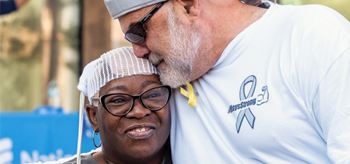Project Impact aims to fundamentally change the way new pediatric cancer therapies are developed and tested, through public policy and a funded research program
National Brain Tumor Society, the largest nonprofit dedicated to the brain tumor community in the United States, today announced the launch of Project Impact: Driving Discovery to a Cure for Pediatric Brain Tumors, an integrated research and drug development program that seeks to confront the unique barriers to better treatments for children with pediatric brain cancer.
Project Impact is comprised of two simultaneous tracks in both research and public policy to overcome a number of interrelated impediments to advancing pediatric brain cancer research. One track will address inefficiencies in pre-clinical drug development for this population, while the second will seek to improve the pediatric clinical trial environment. Together, these efforts will seek to optimize the entire pediatric brain cancer drug discovery and development pipeline.
“After careful analysis and discussions with key leaders across the field of pediatric cancer research, drug development, public policy, and advocacy, it became clear that to improve the lives of children with brain cancer, we need to fundamentally change the way new treatments are developed and tested,” said N. Paul TonThat, CEO, National Brain Tumor Society. “Project Impact’s focus will be working within the field to create the required environment, tools, and processes to deliver better therapies to doctors and patients.”
Advising the National Brain Tumor Society on Project Impact are three luminaries in pediatric brain cancer research:
- Dr. Suzanne Baker, PhD, Co-leader, Neurobiology and Brain Tumor Program – St. Jude Children’s Research Hospital
- Dr. Maryam Fouladi, MD, MSc, FRCPC, Medical Director, Neuro-Oncology Program – Cincinnati Children’s Hospital Medical Center
- Dr. Roger J. Packer, MD, Senior Vice President, The Center for Neuroscience and Behavioral Medicine, Director, Brain Tumor Institute (Neuro-Oncology Program) – Children’s National Medical Center
While survival rates for many childhood cancers have improved significantly in recent decades, pediatric brain tumors, particularly the aggressive class of high-grade gliomas (HGG), have not benefitted from the progress in the larger population. Pediatric HGG patients, like those with astrocytoma or glioblastoma multiforme, have five-year survival rates ranging from just 15-20 percent. Consequently, pediatric brain tumors are the leading cause of cancer-related death in children under 10 years old, and overall survival statistics have not seen real improvement in nearly 40 years.
Though pediatric brain tumors are the second most common form of childhood cancer, HGG only make up 450 – 650 of those cases annually. Despite the devastating effects, the small population size creates many challenges to effective drug development for pediatric HGG.
On the pre-clinical research side, few patients, spread out across the country, means the many pieces of data needed to generate an effective pre-clinical research platform in this area – with statistical power to accurately predict how a potential therapy will interact with a child’s HGG – are siloed in small clusters at many medical and research institutions throughout the world. Thus, efforts within Project Impact will seek to identify and aggregate all of the key models, tissue, and data required to create a single network and new pre-clinical research platform. National Brain Tumor Society is committed to funding this pre-clinical platform for up to $500,000 per year (for five years) with the goal of identifying drugs that will work in pediatric high-grade glioma to move into clinical trials.
Further, several biopharmaceutical companies have already pledged their support to screen and optimize potential therapies identified in pre-clinical research for use in human trials.
On the clinical side, a small patient population combined with complex and different regulations in the U.S. and Europe creates an environment of significant risk, which can reduce the incentive for biopharmaceutical companies to move forward in pediatric brain cancer. To address these issues, Project Impact will work with the biopharmaceutical industry, government agencies, clinicians, researchers, other nonprofit organizations, and coalitions to identify ways to change policy and practice in ways that will improve clinical trial design and expedite approvals of new therapies.
Taken together, the aims of Project Impact seek an improved model for pediatric brain cancer drug development and a more efficient and incentivized environment for stakeholders to pursue new safe and effective therapeutic options for this community. Working groups from a cross section of biopharmaceutical industry representatives, medical academic researchers, clinicians, patient advocates, and policy experts will meet later in March to further refine the direction of Project Impact.
National Brain Tumor Society is committed to directing one-third of its research budget to pediatric-specific initiatives, and has previously undertaken fruitful initiatives in both pediatric brain tumor molecular profiling and developmental neurobiology, which respectively made important contributions to the field of pediatric brain tumor research.
# # #


